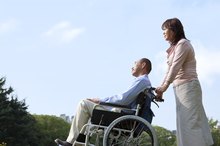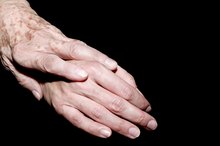What Causes Muscle Loss?
There are many causes for the deterioration of muscles. Muscle wasting, or atrophy, occurs in two basic forms: disuse atrophy in which the muscles waste away due to lack of exercise, and neurogenic atrophy, which is muscle deterioration due to disease or injury. Atrophy of the muscles can be extremely debilitating and can rob sufferers of the ability to walk and take away the basic strength necessary for everyday activities. In some cases, once the cause of the atrophy is identified, surgery and physical therapy can help to counteract the effects of muscle wasting.
Aging and Injury
Aging can cause individuals to become bedridden or disabled to the point where they are almost completely sedentary. When this occurs they lose muscle tone and with time this progresses to atrophy. Significant injury can also lead to muscle atrophy as in cases when a person becomes paralyzed to some extent and his muscles waste away due to lack of use. Aging and injury causes of muscle wasting are classified as disuse atrophy. Physical therapy and proper nutrition are usually prescribed to combat this type of atrophy.
- Aging can cause individuals to become bedridden or disabled to the point where they are almost completely sedentary.
- Significant injury can also lead to muscle atrophy as in cases when a person becomes paralyzed to some extent and his muscles waste away due to lack of use.
Nerve Diseases
What Causes Sagging Face Muscles?
Learn More
Several diseases affect nerves that control the muscles with the result being atrophy. Chief among these illnesses are amyotrophic lateral sclerosis (ALS), which is also known as Lou Gehrig's Disease, Guillain-Barre syndrome and polio. In all three of these diseases the communication between the nerves and muscles is impaired. Muscles lose the ability to function in response to nerve signals and the resulting lack of mobility leads to wasting.
- Several diseases affect nerves that control the muscles with the result being atrophy.
- In all three of these diseases the communication between the nerves and muscles is impaired.
Stroke
A stroke occurs when an artery becomes clogged or bursts, causing blood flow in the brain to be interrupted. The result is a period in which there is lack of oxygen and brain cells die. A stroke can be mild to severe and its consequences can include muscle wasting. Extensive physical therapy is often required to reverse atrophy or, at least, improve muscle tone.
- A stroke occurs when an artery becomes clogged or bursts, causing blood flow in the brain to be interrupted.
- Extensive physical therapy is often required to reverse atrophy or, at least, improve muscle tone.
Motor Neuropathy
Diseases Similar to ALS
Learn More
Motor neuropathy is a condition in which the motor nerve fibers are damaged. This devastation to the motor nerve fibers causes weakness, lack of muscle control and eventual wasting of muscles. A common form of this type of neuropathy is referred to as multifocal motor neuropathy in which there is a progressive weakening and muscle wasting of the arms. Common treatments for motor neuropathy are the administering of cyclophosphamide or human immune globulin (HIG).
- Motor neuropathy is a condition in which the motor nerve fibers are damaged.
- A common form of this type of neuropathy is referred to as multifocal motor neuropathy in which there is a progressive weakening and muscle wasting of the arms.
Muscular Dystrophy
Muscular dystrophy is not one disease but a collective term for a group of muscle weakening disorders that have a genetic (inherited) component. In these diseases the muscle cells and tissues progressively deteriorate and die. These diseases are incurable and worsen with any period of inactivity. Aggressive physical therapy is often the only treatment.
- Muscular dystrophy is not one disease but a collective term for a group of muscle weakening disorders that have a genetic (inherited) component.
Arthritis
Crippling forms of arthritis such as rheumatoid and osteoarthritis lead to muscular atrophy in patients. Arthritis causes inflammation of the joints, making them stiff and causing movement to be difficult. The associated pain of arthritis may cause patients to become extremely sedentary, which leads to muscle wasting. Physicians often prescribe pain medications and anti-inflammatory drugs to ease stiffness and discomfort. Patients are encouraged to exercise in order to help maintain muscle tone and reverse any atrophy that has occurred during sedentary periods.
- Crippling forms of arthritis such as rheumatoid and osteoarthritis lead to muscular atrophy in patients.
- The associated pain of arthritis may cause patients to become extremely sedentary, which leads to muscle wasting.
Related Articles
References
- The New York Times: Muscle Atrophy
- University of Maryland Medical Center: Muscle Atrophy
- University of New Mexico: Sarcopenia -- The Mystery of Muscle Loss
- U.S. National Library of Medicine MedlinePlus. Muscle atrophy. Updated November 22, 2017.
- Adams V. Electromyostimulation to fight atrophy and to build muscle: facts and numbers. J Cachexia Sarcopenia Muscle. 2018;9(4):631–634. doi:10.1002/jcsm.12332
- Muscle atrophy. MedlinePlus.
Writer Bio
Lisa Mooney has been a professional writer for more than 18 years. She has worked with various clients including many Fortune 500 companies such as Pinkerton Inc. She has written for many publications including Woman's World, Boy's Life and Dark Horizons. Mooney holds bachelor's degrees in both English and biology from the University of North Carolina at Charlotte.









